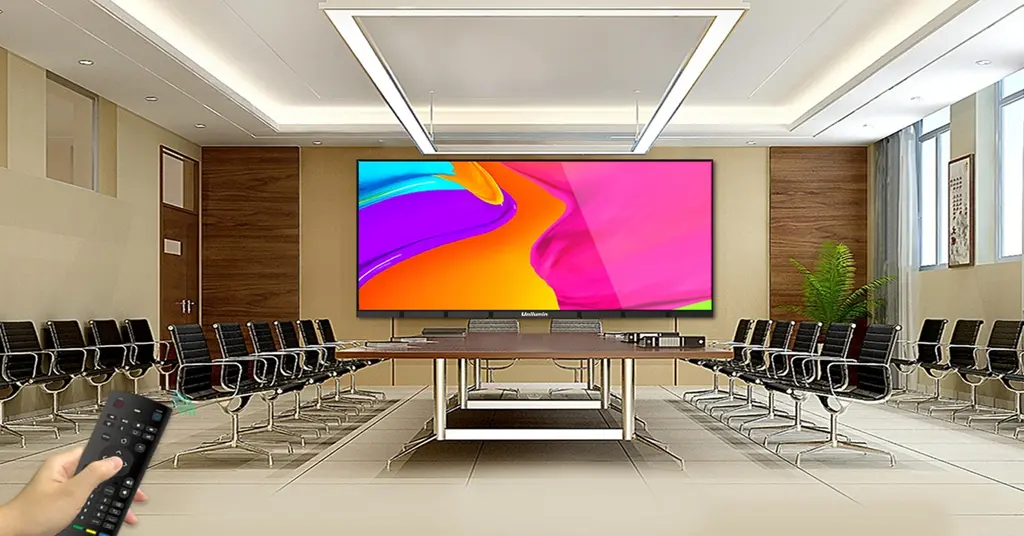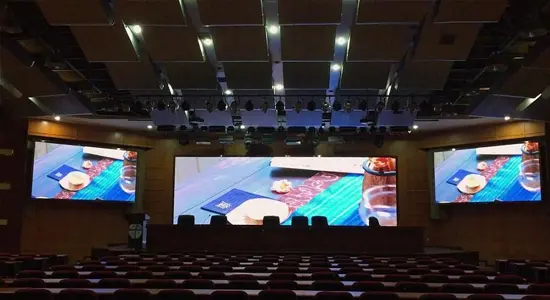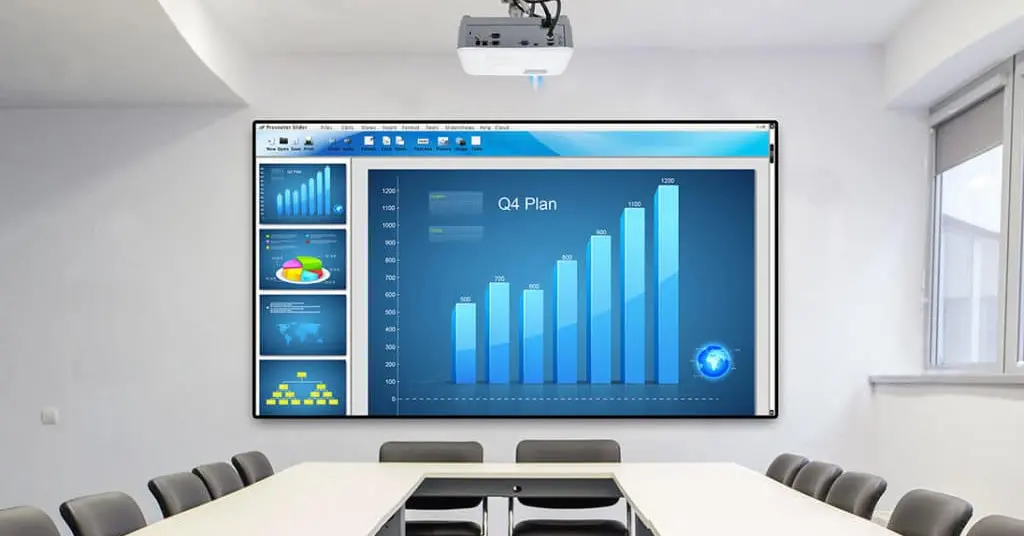LED display vs Projectors: which is the best fit for conference room
Are you hesitating to choose the best conference room AV solution? Are you having a difficult choice between choosing an LED screen or a projector as the display device for a conference room? This article will analyze the differences between LED displays and projectors from multiple perspectives, providing authoritative guidance for selecting the best conference room audio and video solution.
Table of Contents

A. Explanation of LED screens and projectors
LED screens and projectors are two popular display technologies used in conference rooms. LED screens are flat panel displays that use light-emitting diodes to produce bright, high-contrast images. They are available in a range of sizes and resolutions and are commonly used in indoor and outdoor environments. Projectors, on the other hand, use a lens and light source to project an image onto a screen or wall. They are also available in various sizes and resolutions, and can be used for both front and rear projection.
B. Importance of choosing the right technology for conference rooms
Choosing the right technology for conference rooms is essential to ensuring successful meetings and presentations. The technology should be chosen based on the room size, lighting conditions, and the type of content being presented. Factors such as resolution, brightness, and contrast should also be considered. For instance, if the room is large and bright, a high-brightness projector or LED screen may be necessary to ensure the content is visible to all attendees. Similarly, if the content being presented is highly detailed, a high-resolution display may be needed.
C. Brief overview of the article's content
This article provides an overview of LED screens and projectors, and the importance of choosing the right technology for conference rooms. It discusses the features and benefits of each technology, and provides guidance on selecting the appropriate technology based on room size, lighting, and content. The article also highlights some common considerations when selecting conference room technology, such as resolution, brightness, and contrast. By following these guidelines, businesses can ensure that their conference rooms are equipped with the right technology to facilitate successful meetings and presentations.
A. Advantages of LED screens
LED screens have become increasingly popular over the past decade due to their many benefits over traditional display technologies. With their high-quality visuals, brightness and contrast, and reliability and durability, LED screens have proven to be the go-to choice for many applications, including outdoor advertising, digital signage, and live events.
1. High-quality visuals
LED screens offer unmatched clarity and vibrancy, making them ideal for displaying high-resolution images and videos. They can produce a wide range of colors and shades, with consistent brightness and contrast levels across the entire screen, ensuring that the content is always visually stunning.
2. Brightness and contrast
LED screens are known for their exceptional brightness and contrast, making them highly visible even in bright outdoor environments. They use energy-efficient LED lamps that emit light directly towards the viewer, resulting in better visibility and sharper images.
3. Reliability and durability
LED screens are highly durable and reliable, with a lifespan of up to 100,000 hours. They are designed to withstand extreme weather conditions, including rain, wind, and extreme temperatures, making them ideal for outdoor use. Additionally, they are easy to maintain and can be repaired quickly in case of any damage or malfunction.


B. Drawbacks of LED screens
While LED screens have become increasingly popular for their bright, high-quality displays, there are also some significant drawbacks to consider. Two major concerns include cost and installation/maintenance.
1. Cost
LED screens can be quite expensive, especially when compared to traditional display technologies like LCD or plasma screens. Additionally, the cost of LED screens can vary widely depending on factors such as the size and resolution of the screen, as well as the level of customization required for a particular project. As a result, LED screens may not be feasible for all budgets.
2. Installation and maintenance
Installing and maintaining LED screens can also be more complex and time-consuming than other types of displays. This is partly because LED screens require specialized mounting hardware and electrical connections, and may also need to be calibrated to ensure optimal performance. Ongoing maintenance can also be a challenge, as LED screens can be more prone to issues like dead pixels or color calibration problems that require professional attention.
C. Considerations for choosing an LED screen
When selecting an LED screen for a conference room or any other setting, several factors should be taken into account to ensure that the display meets the intended requirements. Room size and layout, viewing distance and angles, and the purpose of the conference room are among the most important considerations.
1. Room size and layout
Room size and layout determine the size and type of LED screen that would be most suitable for the space. For instance, a large conference room with a high ceiling would require a bigger screen than a smaller room with a lower ceiling.
2. Viewing distance and angles
Viewing distance and angles are also crucial considerations, as they affect the clarity and visibility of the screen. If the display is meant to be viewed from a distance, a larger screen with a higher resolution would be required. On the other hand, if the screen is viewed from different angles, an LED display with a wider viewing angle would be preferable.
3. Purpose of the conference room
The purpose of the conference room should also be taken into account when selecting an LED screen. If the room is mainly used for video conferencing, a high-resolution screen with good color accuracy and brightness would be ideal. Alternatively, if the room is used for presentations or training sessions, a screen with a larger display area and good connectivity options may be more suitable.
A. Explanation of LED screens and projectors
Projectors have become a popular alternative to traditional TV screens and monitors for both personal and professional use. There are numerous benefits to using projectors, including their flexibility and portability, cost-effectiveness, and large display size.
1. Flexibility and portability
One of the most significant advantages of projectors is their flexibility and portability. Unlike traditional TVs or monitors, projectors can be easily moved from one location to another, making them ideal for businesses and individuals who need to frequently present to different audiences. Additionally, projectors can be used to project images onto a variety of surfaces, from walls and screens to outdoor surfaces, providing even more flexibility in how they can be used.
2. Cost-effectiveness
Another advantage of projectors is their cost-effectiveness. In general, projectors tend to be less expensive than high-end TVs or monitors of the same size. Additionally, projectors can be used with inexpensive screens or even plain white walls, eliminating the need to purchase an additional expensive display.
3. Large display size
projectors offer a significantly larger display size than most TVs or monitors. This makes them ideal for use in large venues, such as auditoriums or conference rooms, where a large audience needs to see the same image simultaneously. Additionally, the large display size of projectors can make watching movies, playing video games, or giving presentations more immersive and engaging.

B. Drawbacks of projectors
1. Image quality
Projectors are widely used in various settings, from classrooms to business meetings, and home entertainment. However, like any technology, they come with their drawbacks. One of the most significant drawbacks of projectors is their image quality. Although projectors offer large screen sizes, the quality of the images projected may not be as sharp or detailed as those displayed on high-end televisions or monitors. Subsequently, the projected images may be blurry or distorted, making it difficult for viewers to read text or see small details.
2. Brightness and contrast
Another drawback of projectors is their brightness and contrast. Projectors require a relatively dark room to display images accurately, and they are susceptible to ambient light interference. Even in a dark room, projectors may struggle to produce bright and vivid images, making it challenging for viewers to discern between different shades and colors. Moreover, projectors can be sensitive to contrast, resulting in a lack of detail in darker areas of the image.
3. Maintenance and replacement costs
Projectors can be costly to maintain and replace. Projector bulbs have a limited lifespan and require frequent replacement, which can add up to a significant cost over time. Additionally, projectors may require regular maintenance, such as cleaning filters and ensuring proper ventilation, to prevent overheating and other issues that can affect their performance. Overall, while projectors offer many benefits, it’s essential to consider their drawbacks before making a purchasing decision.


C. Considerations for choosing a projector
1. Room size and layout
When selecting a projector for your conference room, there are several important factors to consider. One of the most significant considerations is the room size and layout. A large conference room with high ceilings will require a projector with greater brightness and throw distance, while a smaller room may only need a basic projector.
2. Ambient lighting
Another important consideration is ambient lighting. If your conference room has windows that let in natural light or if there are bright overhead lights, you will need a projector with a higher brightness rating. A projector with a brightness rating of at least 3,000 lumens is recommended for rooms with ambient lighting.
3. Purpose of the conference room
The purpose of the conference room is also a critical factor to consider. If the conference room is used primarily for presentations or video conferencing, then a standard business projector may suffice. However, if the conference room is used for movie screenings or other entertainment purposes, a home theater projector with higher resolution and contrast may be more suitable.
Choosing the right display for a conference room is crucial for making a lasting impression on clients and colleagues. The two main options available are LED screens and projectors, both of which have their advantages and disadvantages. To help you make an informed decision, here are some key factors to consider.
1. Cost
LED screens are typically more expensive than projectors, especially for larger sizes. However, LED screens have a longer lifespan and require less maintenance, making them a better long-term investment.
2. Image quality
Both LED screens and projectors have come a long way in terms of image quality, but LED screens still generally have the edge when it comes to sharpness and color accuracy. Projectors, on the other hand, offer a larger maximum image size and can be more versatile in terms of placement.
3. Viewing angles and distances
LED screens generally have better viewing angles, meaning that everyone in the room can see the image clearly, no matter where they are sitting. Projectors can struggle with this, especially if the room is bright or has lots of ambient light. However, projectors can be a good choice for larger rooms where the audience is sitting farther away from the screen.
4. Maintenance and replacement costs
The purpose of the conference room should also be taken into account. If the room is primarily used for presentations, an LED screen may be the better choice due to its superior image quality and ease of use. If the room is used for video conferencing or webinars, a projector may be more suitable, as it can display the image larger and is easier to adjust for different camera angles.
Others also read the following article
Want to know more about the Audio Visual Solutions?
